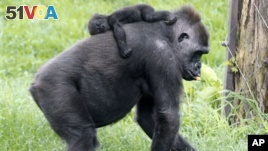April 09,2015
A new action plan has been unveiled to protect Central Africa’s gorillas and chimpanzees. It outlines threats to the great apes across six countries.
The regional action plan is a joint effort by the International Union for Conservation of Nature, Wildlife Conservation Society, and World Wildlife Fund among others.
Dr. Fiona Maisels, a conservation scientist for the Wildlife Conservation Society, said the plan aims to protect the large number of great apes not in protected areas.

FILE - Moka, an endangered western lowland Gorilla, carries her unnamed 3-month-old baby on her back at the Pittsburgh Zoo and Aquarium in Pittsburgh, May 2, 2012.
“The take home message is that most of the apes are not in the national parks. They are spread out throughout the whole of this region," she said. "We really need to concentrate on protecting them, not only in the parks, but in the areas where they’re much more vulnerable to hunting.”
Maisels said the chimpanzees are faring better than the gorillas in Central Africa. But both are threatened by hunting, habitat loss and disease.
The nearly 80 percent of great apes outside protected zones, are in areas where private extractive industries operate.
“Most of the rest of the forest domain of Central Africa is under selective logging, which means that the forestry companies are not clear cutting. They don’t do what they do in Malaysia or Brazil, for example," she said. "They just take out a few trees per acre, which means that the forest afterwards is fine for great apes, and indeed, elephants to live in. The problem is the hunting.”
Maisels said African nations need private industry’s help in saving the great apes.
“So, logging companies need to put in place anti-poaching measures to make sure that important endangered wildlife species are not hunted,” she said.
Maisels said, however, that hunting is important for many local inhabitants.
“People will hunt around villages in Africa to eat. That doesn’t pose a problem to the species that they normally eat, which [are] small antelopes that live in the forest and large rodents, you know, rather like large rates and things like that," she said. "But when commercial hunting takes hold much larger animals get caught, whether deliberately or by accident, and then those animals are sent to large urban markets.”
The Wildlife Conservation Society scientist said the long-term survival of chimps and gorillas is put at risk by commercial hunting.
“It’s not a food security issue. It’s basically a conservation issue if a great ape gets caught in a snare or if a great ape gets shot," Maisels said. "Great apes, like elephants, are much less able to reproduce rapidly to reproduce the numbers that have been killed. And that’s why they’re both on endangered species lists. That’s why they’re both on nationally protected species lists,” she said.
The Regional Action Plan for the Conservation of Western Lowland Gorillas and Central Chimpanzees also highlights another big threat – Ebola.
“We lost thousands and thousands of great apes along the Gabon-Congo border about 10 years ago with a massive Ebola epidemic," Maisels said. "Nothing like as big as the one we’ve seen in West Africa. And it wiped out huge areas of gorillas and chimps in the forest before it got into the villages. The only reason we knew about it was because people started getting sick. And that’s because they were finding dead animals in the forest – picking them up – taking them home and eating them. And then of course it went through villages just it’s done in West Africa.”
Maisels added that current Ebola vaccine research could lead to protection for humans and apes alike.
“If a vaccine can be developed that can be transmitted from ape to ape, once a few apes in the forest have been vaccinated, that would effectively vaccinate the whole population." she said. "We’re a long way from that at the moment, but there are people who are trying to do that, which would, of course, not only protect great ape populations, but would eventually protect all the human populations who are working within their forests.”
The action plan also calls for “improved legal frameworks and stiffer sanctions for poachers; coordinated use and protection of natural resources with a priority on conserving great ape populations; and conservation advocacy to bring about behavior change toward great apes.”
The previous action plan was released in 2005 and is credited with slowing the decline in ape populations.